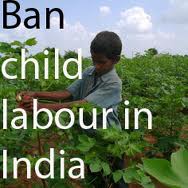Did India’s Child Labor Ban Increase Child Labor?
< < Go Back
 India’s 1986 ban on child labor actually led to increases in child labor while decreasing children’s wages, say Prashant Bharadwaj, Leah K. Lakdawala and Nicholas Li, researchers with the National Bureau of Economic Research.
India’s 1986 ban on child labor actually led to increases in child labor while decreasing children’s wages, say Prashant Bharadwaj, Leah K. Lakdawala and Nicholas Li, researchers with the National Bureau of Economic Research.
– India banned child labor in a number of occupations and process, including passenger transport, foundry work and various types of manufacturing jobs.
– For the areas in which child labor was not banned, India imposed restrictions on children’s working hours.
– The law was weakly enforced.
But unintended consequences are always a concern when laws and regulations are passed:
– Rather than increasing an employer’s hiring cost (and deterring the use of child labor), the researchers found that the child labor ban actually led to more child labor, because poor families had to supply more child labor in order to subsist.
– For those households most affected by the ban, there was a reduction in their children’s schooling that corresponded with the increase in employment.
– The study found that the ban led to small decreases in household welfare.
– Child wages relative to adult wages dropped in response to the labor law.
The authors caution that well-intentioned laws can often have perverse consequences, as was the case with India’s child labor ban.
More From NCPA:



